The Microsoft Surface Studio Review
by Brett Howse on January 20, 2017 8:00 AM EST- Posted in
- Desktop
- Microsoft
- Surface
- Surface Studio
System Performance
As is typical with an all-in-one PC, the Surface Studio uses mobile parts to ensure things don’t get too toasty. The base model ships with a Core i5-6440HQ, which is a quad-core processor running at 2.6-3.5 GHz. There is 6 MB of cache and no hyperthreading, and it has a 45-Watt TDP. The CPU is likely fine for most tasks, but the base Surface Studio comes with just 8 GB of DDR4 memory, which would hardly be called adequate for an almost $3000 computer. Graphics to run the 13.5 million pixel display come courtesy of the NVIDIA GeForce GTX 965M, launched at CES in 2015.
The jump up to the mid-level model offers a lot more computer, but comes at a cost of an additional $500. The CPU is upgraded to the Core i7-6820HQ, which is a quad-core with hyperthreading, and a 2.7-3.6 GHz frequency, along with 8 MB of cache. The big upgrade is the RAM, which doubles to a more respectable 16 GB, and while the GPU is the same, and the hard drive capacity is the same, the mid-level model doubles the SSD cache from a 64 GB SATA SSD to a 128 GB PCIe SSD. While the CPU is going to offer more performance, especially in heavily-threaded workloads, the increased RAM and SSD cache are likely to do more for the overall performance than anything, and the mid-level is really where the Surface Studio should have started.
Our review unit is the top level model, with the same Core i7-6820HQ CPU as the mid-level model, but with double the RAM again, which means 32 GB of DDR4. The hybrid hard drive capacity is also doubled, to 2 TB, with the same 128 GB of PCIe SSD cache. The biggest upgrade on the top model is the graphics, which jumps from the GeForce GTX 965M all the way to the GeForce GTX 980M. This was the top mobile graphics card available until earlier this year when the GeForce GTX 10 series launched, and it offers quite a bit more performance. The GTX 965M was a solid performer for low-end gaming, but the GTX 980M offers more of everything, with double the video memory to 4 GB, more memory bandwidth, more CUDA cores, and far more performance.
Much has been made of the fact that the Surface Studio shipped with “old technology” in a Skylake CPU, when Kaby Lake CPUs were available, and especially the Maxwell based graphics, when Pascal was launched. The CPU argument was never true though, with quad-core Kaby Lake only available since the beginning of 2017, and Kaby Lake offers no IPC increases over Skylake, although they can run at a higher frequency for the same power consumption. The GPU argument is sound though, and the Pascal based GPUs would offer greater performance for less power consumption, and therefore less heat generated. The new GPUs are not pin-compatible though, meaning Microsoft would have had to redesign the board completely, as well as possibly addressed the different TDPs of the mobile chips, but this would have been engineering time well spent.
| NVIDIA Mobile Maxwell GPUs | |||||
| GeForce GTX 965M | GeForce GTX 980M | ||||
| CUDA Cores | 1024 | 1536 | |||
| Core Clock | 944 + Boost | 1038 + Boost | |||
| Memory | 2 GB GDDR5 128-bit | 4 GB GDDR5 256-bit | |||
| Memory Clock | 2500 MHz | 2500 MHz | |||
| Memory Bandwidth | 80 GB/s | 160 GB/s | |||
Ultimately, it would have been nice to see a GTX 1070 and GTX 1060 options, or even a GTX 1050 to replace the GTX 965M, although that GPU just launched for laptops at CES 2017. The performance increases alone would be significant, but there are also advantages such as full hardware decode for HEVC on the Pascal chips which would have been a nice feature. Clearly the timing did not work out, and Microsoft said they had to choose the components a year before launch. They likely didn’t want to risk choosing Pascal and then having supply issues, but at the end of the day they made a conservative decision.
So let’s see how the Surface Studio does perform, with the Skylake and Maxwell combination that is available. The Surface Studio was run through our standard suite of tests, and for comparisons it is put up against some of the more recent laptops we’ve tested.
PCMark
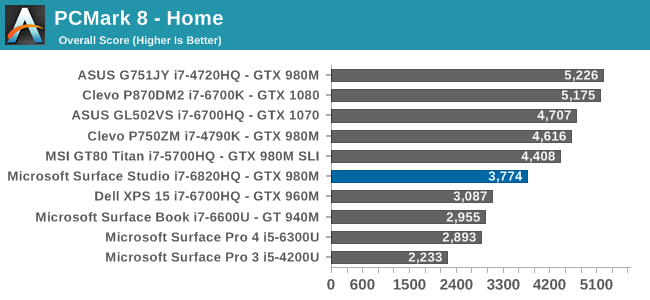

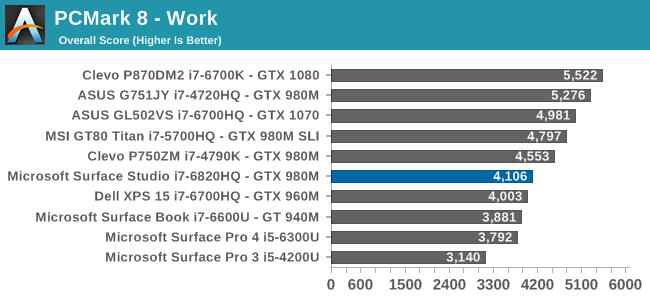
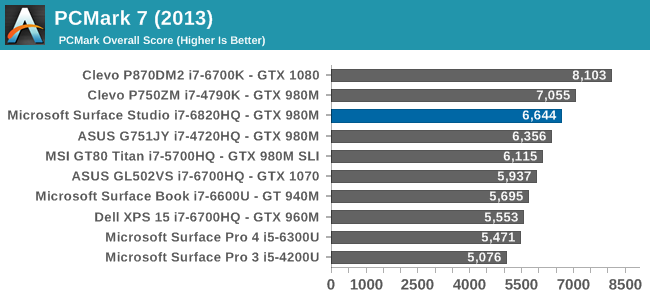
PCMark is a comprehensive set of tests, which uses real-world applications to test system responsiveness and performance. All aspects of the system are tested, including the storage, and even display resolution can have an affect. Here the Surface Studio is decidedly average, with decent scores in some tests, but less than amazing results in others. The hybrid storage and high display resolution likely didn’t help out the Surface Studio here.
Cinebench
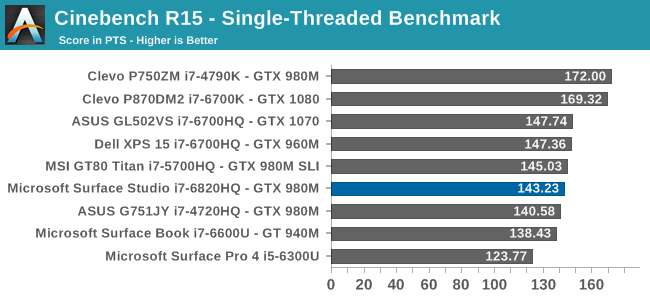
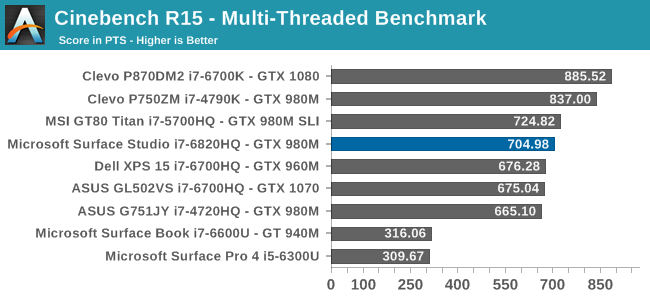
Cinebench is a purely CPU test, and despite the Surface Studio having a Core i7-6820HQ when most quad-core laptops are the i7-6700HQ, it still fell slightly below them on this test.
X264
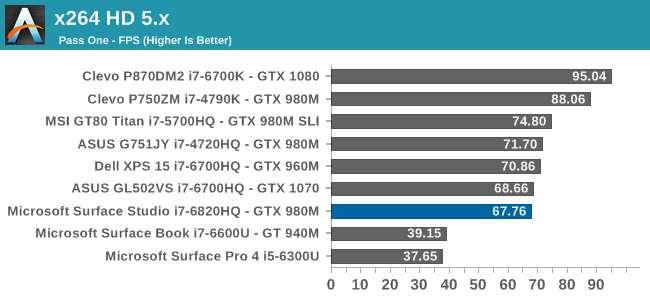
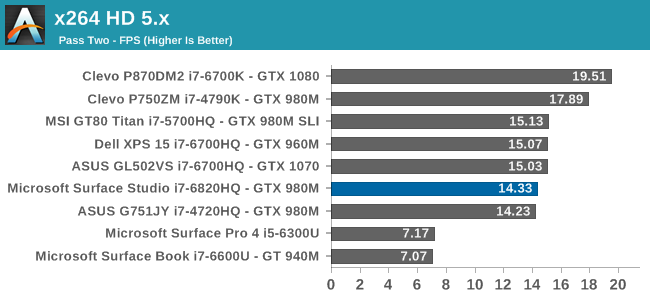
Much like Cinebench, this is a pure CPU test, but unlike Cinebench which renders an image, x264 encodes a video file. As with Cinebench, the Surface Studio falls a bit under the performance of the i7-6700HQ found in most notebooks.
Web Tests
Browsing the web is likely what most computers do, most of the time, but unlike the previous tests, web tests are always evolving over time as the underlying browsers are updated. For our tests, we use the latest version of Microsoft Edge.
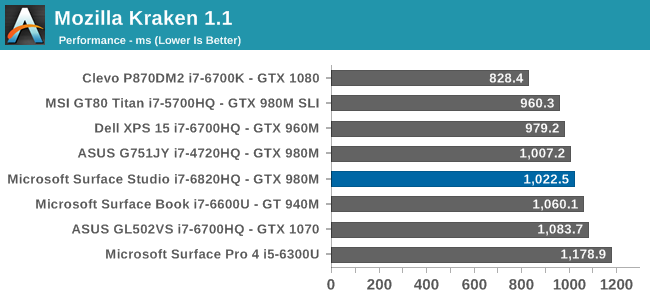
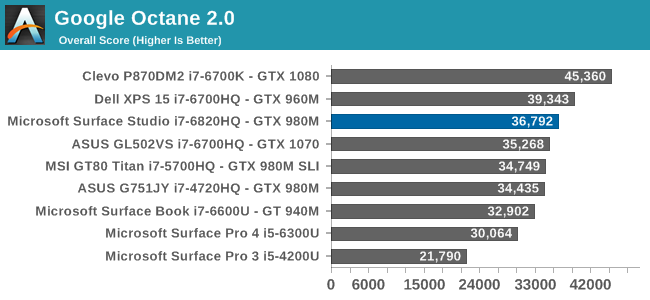

As with the other tests, the Surface Studio falls just a hair under the performance of typical quad-core laptops. With a sample size of one, it’s difficult to point the finger at why this is – is it cooling or is it something else – but I would have expected it to be just slightly ahead of the i7-6700HQ machines.










197 Comments
View All Comments
casperes1996 - Friday, January 20, 2017 - link
The Surface Display + a new Mac Pro = yes! I know it eliminates the point of touch, but I don't care much for it either way. I love the rest of the display design though.simonm - Sunday, January 22, 2017 - link
You know something about a new Mac computer? Do tell!TheinsanegamerN - Monday, January 23, 2017 - link
Oh, it's great! they've moved to the new intel U series chips to give us a smoother, more complete experience, and a new geforce 940MX graphics card for CUDA acceleration! They start at the new price of $2400 for the bast model, and $3200 for the model with more then 4GB soldered to the mobo.Gich - Friday, January 20, 2017 - link
"The GTX 980M handles desktop duties just fine, but if you do want to stretch its legs with some games [...]"Games? With this? Why?
TheinsanegamerN - Friday, January 20, 2017 - link
perhaps some creative professionals would like to play a game of civ now and again?ddriver - Friday, January 20, 2017 - link
Actually many of the professional applications are just as demanding to GPU performance, even not even more, because besides graphics there is also compute.All in all, this product is silly, good screen, decent design, but the specs are disappointing. A spinner drive in a 4200$ product, seriously?
Replace in the drive with a nvme, replace the gpu with a 1070, and at the same price point, I might consider buying it.
ddriver - Friday, January 20, 2017 - link
And while other products are being lousy by only having USB C ports, this one does the exact opposite, it is being lousy by only having A ports.If 4 is the limit, then it should be 2 A, 1 C and one thunderbolt.
gerz1219 - Friday, January 20, 2017 - link
What's interesting is that creative professionals are already a niche market, but by offering midrange laptop performance, they're basically cutting out a large segment of that niche -- video editors with demanding workflows, motion graphics artists, digital compositors, and basically anyone working in 3D. The Studio seems to be aimed primarily at photo editors and graphic designers who spend all day in less demanding applications, but that's a niche of a niche, and lots of those other users I mentioned would love a high-resolution touch display with pen input.Would be interesting if they competed directly with the Wacom Cintiq line, because that display is much better than what Wacom currently has on offer.
simonm - Sunday, January 22, 2017 - link
Very good summation. Plus the 3:2 aspect ratio isn't ideal for videographers. This seems to be for digital artists, photographers, desktop publishers and the like.With those specs and prices I certainly don't see this thing flying off the shelf but it's a decent first attempt.
TheinsanegamerN - Monday, January 23, 2017 - link
hasnt it already sold out?